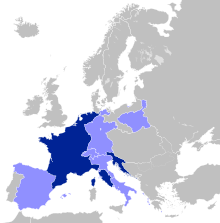
The Organic Articles (French: Articles Organiques) was a law administering public worship in France.

The Organic Articles (French: Articles Organiques) was a law administering public worship in France.
The Articles were originally presented by Napoleon Bonaparte, and consisted of 77 Articles relating to Catholicism and 44 Articles relating to Protestantism. It was published as a unilateral addition to the Concordat of 1801, which is also sometimes referred to as the "French Concordat," on 8 April 1802. Napoleon had it presented it to the Tribunate and the legislative body at the same time that he had them vote on the Concordat itself. It met with opposition from the Catholic Church with Pope Pius VII claiming that the articles had been promulgated without his knowledge. [1]
Presenting the Organic Articles was Napoleon’s method of granting the Tribunat and the Corps législatif partial control of the concordat in order to help the state monitor any politically harmful Catholic or Protestant movements or activities. In 1797, two years before Napoleon seized power, there had been a revolt in the Vendée of lay Catholics which had been brutally suppressed. This incident is believed to have inspired the Organic Articles. It was also an attempt to prevent any more religious strife in French cities[ citation needed ]. For example, Article 45 states, “In cities where there are temples dedicated to different religions, no religious ceremony is to take place outside of the buildings consecrated for Catholic worship.” [2] In towns with adherents of different dogmas, public processions were prohibited.
Title I – “Of the governance of the Catholic Church in its general relations with the rights and the police of the state”, required the authorisation of the Government for the publication and execution of a papal document in France. [1]
Title II – “Of the Ministers” declared the power of ministers and regulated public worship, stating that rules and regulations of seminaries must be presented to the State, the number of those to be ordained must be fixed yearly by the Government, and curés of important parishes cannot be appointed by the bishop without the consent of the State. [1]
Title III – “Of the forms of worship” explained not only restriction of public processions, but the proper clerical dress code, instructing, "All ecclesiastics will be dressed in the French manner in black." [2] It forbade public processions in towns where there are adherents of different creeds, and it prescribed that there shall be only one catechism for all the churches of France. The Imperial Catechism taught that love, respect, and obedience to the emperor were religious obligations. [3]
Title IV – “Of the circumscription of the archbishoprics, bishoprics and parishes, of the buildings intended for worship and of the salaries for the ministers” specified boundaries for the jurisdictions of bishops and the amounts of their salaries.
The Articles allowed the use of church bells, but put this under the joint jurisdiction of the bishop and the prefect. The government exercised control over religious holidays. The Feast of the Assumption (August 15) was one of the holidays retained. It also happened to be Napoleon's birthday. [3]
These articles were largely similar to the Catholic regulations; Protestants favoured parts of the Articles preventing Catholic domination in France. The Calvinist community, a variety of Protestant Christianity, was divided into congregations of adherents governed by clerical leaders appointed by wealthy or powerful taxpayers. Parallel to the Articles relative to Catholicism, the pastors were salaried by the State, and following this, a Calvinist revival was held by the Protestants.
According to Nicholas Atkin:
"Ostensibly these dealt with the policing arrangements referred to in Article 1, but in practice they went much further. Government approbation was required before papal pronunciations could be published, councils convoked, new parishes established and chapels set up. A uniform catechism was introduced, church weddings could not precede the civil ceremony, cathedral chapters were reduced to merely ceremonial function and the powers of papal delegates were severely circumscribed. Any breach of the articles was treated as a criminal offence and was referred to the Council of State.... Although it was not specifically referred to in the Organic Articles, the creation of a Ministry of Cults in 1801 reinforced a drive towards government oversight of ecclesiastical matters." [4]
The Organic Articles read as a list of solutions to past problems in France, such as clerical abuses and sectarian altercations, and was also concerned by the Catholic Church to be a subtle attempt by the State to gain further control of the Church. Napoleon sought to allow the right amount of Catholicism, but not a large amount, in order to prevent further rebellion from the Protestants, therefore issuing of the Organic Articles was considered to be a fault in French Catholicism. Although it restricted specific religious practices in France, it partially allowed other religious freedoms yet still remained in favour of the State. A limited or regulated amount of worship was given, or simply enough to pray for the Republic. Minor issues were addressed in the Articles, but peace between theological controversies was not achieved.
The Concordat was presented to Pope Pius VII for a signature of approval, along with Napoleon’s attachment of the Organic Articles, which somewhat abates parts of the Concordat. The Pope protested against the Organic Articles, saying he had no knowledge of Napoleon's attachment at the time of the agreement, but the protest was in vain. Finally, Pius was humiliated and defeated by the publishing of the Articles. This raised more difficulties for the Pope than solved them. [5]
Though Pius' disapproval was disregarded by Napoleon, many of the Articles eventually became a dead letter. The obscurities of many of them were later shown to be irrelevant, and the need to enforce the laws was unnecessary.
In 1905, the French law was issued declaring the separation of church and state in France. This abolished the Organic Articles along with the Concordat of 1801. [6] However, in the departments of Alsace and Moselle, in 1905 not part of France, the organic articles remain in power (see local law in Alsace-Moselle).

Pope Pius VII was head of the Catholic Church from 14 March 1800 to his death in August 1823. He ruled the Papal States from June 1800 to 17 May 1809 and again from 1814 to his death. Chiaramonti was also a monk of the Order of Saint Benedict in addition to being a well-known theologian and bishop.

The Concordat of 1801 was an agreement between Napoleon Bonaparte and Pope Pius VII, signed on 15 July 1801 in Paris. It remained in effect until 1905, except in Alsace–Lorraine, where it remains in force. It sought national reconciliation between revolutionaries and Catholics and solidified the Roman Catholic Church as the majority church of France, with most of its civil status restored. This resolved the hostility of devout French Catholics against the revolutionary state. It did not restore the vast Church lands and endowments that had been seized during the French Revolution and sold off. Catholic clergy returned from exile, or from hiding, and resumed their traditional positions in their traditional churches. Very few parishes continued to employ the priests who had accepted the Civil Constitution of the Clergy of the revolutionary regime. While the Concordat restored much power to the papacy, the balance of church-state relations tilted firmly in Napoleon's favour. He selected the bishops and supervised church finances.
In the history of Germany, the Kulturkampf was the seven-year political conflict (1871–1878) between the Catholic Church in Germany, led by Pope Pius IX, and the Kingdom of Prussia, led by chancellor Otto von Bismarck. The Prussian church-and-state political conflict was about the Church's direct control over both education and ecclesiastical appointments in the Prussian kingdom as a Roman Catholic nation and country. Moreover, when compared to other church-and-state conflicts about political culture, the German Kulturkampf of Prussia also featured anti-Polish bigotry fueled by "racist anxieties" in Germany "about the Polish portions of the Prussian East."
The relations between the Catholic Church and the state have been constantly evolving with various forms of government, some of them controversial in retrospect. In its history, the Church has had to deal with various concepts and systems of governance, from the Roman Empire to the medieval divine right of kings, from nineteenth- and twentieth-century concepts of democracy and pluralism to the appearance of left- and right-wing dictatorial regimes. The Second Vatican Council's decree Dignitatis humanae stated that religious freedom is a civil right that should be recognized in constitutional law.
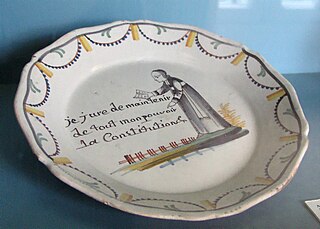
The Civil Constitution of the Clergy was a law passed on 12 July 1790 during the French Revolution, that sought the complete control over the Catholic Church in France by the French government. As a result, a schism was created, resulting in an illegal and underground French Catholic Church loyal to the Papacy, and a "constitutional church" that was subservient to the State. The schism was not fully resolved until 1801. King Louis XVI ultimately granted Royal Assent to the measure after originally opposing it, but later expressed regret for having done so.
A concordat is a convention between the Holy See and a sovereign state that defines the relationship between the Catholic Church and the state in matters that concern both, i.e. the recognition and privileges of the Catholic Church in a particular country and with secular matters that affect church interests.
Vehementer Nos was a papal encyclical promulgated by Pope Pius X on 11 February 1906. He denounced the French law on the Separation of the Churches and the State enacted two months earlier. He condemned its unilateral abrogation of the Concordat of 1801 between Napoleon I and Pope Pius VII that had granted the Catholic Church a distinctive status and established a working relationship between the French government and the Holy See. The title of the document is taken from its opening words in Latin, which mean "We with vehemence".
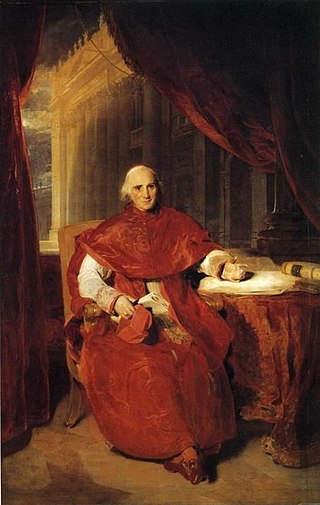
Ercole Consalvi was a deacon and cardinal of the Catholic Church, who served twice as Cardinal Secretary of State for the Papal States and who played a crucial role in the post-Napoleonic reassertion of the legitimist principle of the divine right of kings, of which he was a constant supporter.

The 1905 French law on the Separation of the Churches and State was passed by the Chamber of Deputies on 3 July 1905. Enacted during the Third Republic, it established state secularism in France. France was then governed by the Bloc des gauches led by Émile Combes. The law was based on three principles: the neutrality of the state, the freedom of religious exercise, and public powers related to the church. This law is seen as the backbone of the French principle of laïcité (secularism). It is however not applicable in Alsace and Moselle, which were part of Germany when it was enacted.
The aim of a number of separate policies conducted by various governments of France during the French Revolution ranged from the appropriation by the government of the great landed estates and the large amounts of money held by the Catholic Church to the termination of Christian religious practice and of the religion itself. There has been much scholarly debate over whether the movement was popularly motivated or motivated by a small group of revolutionary radicals. These policies, which ended with the Concordat of 1801, formed the basis of the later and less radical laïcité policies.
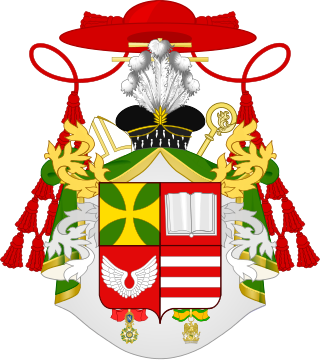
Giovanni Battista Caprara Montecuccoli was an Italian statesman and cardinal and archbishop of Milan from 1802 to 1810. As a papal diplomat he served in the embassies in Cologne, Lausanne, and Vienna. As Legate of Pius VII in France, he implemented the Concordat of 1801, and negotiated with the Emperor Napoleon over the matter of appointments to the restored hierarchy in France. He crowned Napoleon as King of Italy in Milan in 1805.

The majority of the religious population in France identifies as Christian. Catholicism is the most prominent denomination in France, but has long lost the state religion status it held prior to the 1789 French Revolution and during various non-republican regimes of the 19th century, including the Restoration, the July Monarchy and the Second French Empire.

The Napoleon Tiara was a papal tiara given to Pope Pius VII in June 1805 a few months after he presided at the coronation of Napoleon I. While lavishly decorated with jewels, it was deliberately too small and heavy to be worn and meant as an insult to the Pope. In the painting of The Coronation of Napoleon by Jacques-Louis David, the tiara is held behind the Pope by one of his aides.

Paul-Thérèse-David d'Astros was a French Roman Catholic Cardinal and archbishop.
The history of the Catholic Church is the formation, events, and historical development of the Catholic Church through time.

The history of the Catholic Church in France is inseparable from the history of France, and should be analyzed in its peculiar relationship with the State, with which it was progressively confused, confronted, and separated.
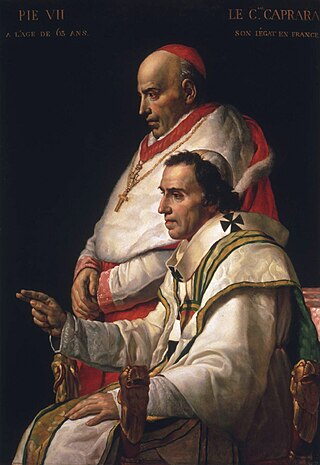
The relationship between Napoleon and the Catholic Church was an important aspect of his rule.
The modern history of the papacy is shaped by the two largest dispossessions of papal property in its history, stemming from the French Revolution and its spread to Europe, including Italy.
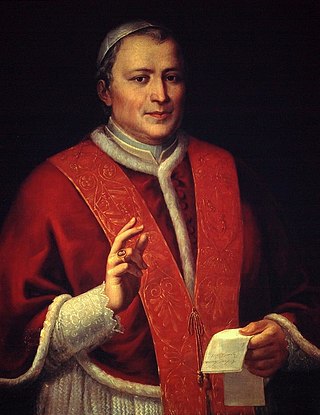
On 4 March 1853, Pope Pius IX restored the episcopal hierarchy in the Netherlands with the papal bull Ex qua die arcano, after the Dutch Constitutional Reform of 1848 had made this possible. The re-establishment of the episcopal hierarchy led to the April movement protest in 1853.
Protestantism was generally proscribed in France between 1685 and 1787. During that period Roman Catholicism was the state religion. The French Revolution began a process of dechristianisation that lasted from 1792 until the Concordat of 1801, an agreement between the French state and the Papacy. The French general and statesman responsible for the concordat, Napoleon Bonaparte, had a generally favourable attitude towards Protestants, and the concordat did not make Catholicism the state religion again.